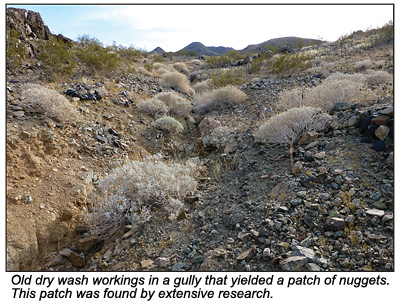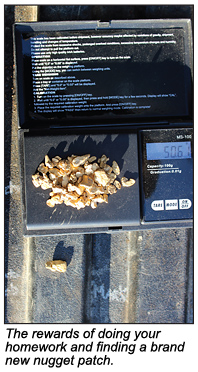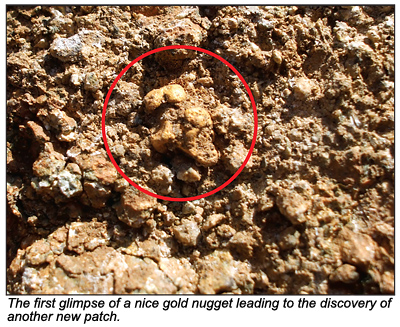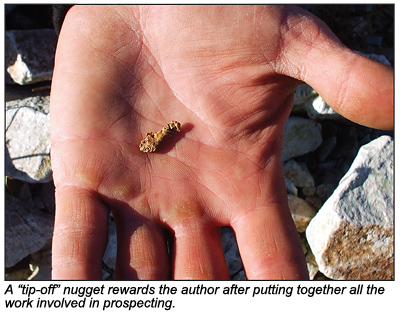Prospecting & Detecting
Free / Prospecting & Detecting
The Story Behind the Story
March 2013 by Michael
The sun just peaking over the bare desert hills casts a pale pink light on their eastern faces. The hum of the detector fresh in the ears and a slight break in the threshold beckons the pick to break the ground for the first time. A few whacks into rotten bedrock and a sifting of the material in a plastic scoop reveals a flash of yellow.  This is how a recent day prospecting started for me. And this is how many new prospectors imagine prospecting will be. However, a large portion of the story of unearthing that nugget was left out. The truth is, that prospecting day involved many hours and days beforehand to lead me to that nugget.
This is how a recent day prospecting started for me. And this is how many new prospectors imagine prospecting will be. However, a large portion of the story of unearthing that nugget was left out. The truth is, that prospecting day involved many hours and days beforehand to lead me to that nugget.
It started in the warmth of my bed as I looked over an old state issued publication from the early part of the 20th century. In reading it I found a place where placer miners had extracted a healthy amount of gold in the late 1800s. No mention of the size of the nuggets was given, but nearby areas and different publications revealed a history of nuggets.
The Internet is one of the biggest assets to modern prospecting. That book I was reading may have been one hundred years old, but I would never have had access to it if some enterprising individual had not uploaded a copy of it on the web. Thank you, whoever you are. Sites such as archive.org have not only preserved these valuable written histories, but also made them available to the masses.
 Anyone who has found a patch knows the difficulties involved. Those who haven’t can guess, and with any effort will soon realize it. Modern prospectors are a close-knit group and enjoy sharing experiences on Internet forums. Don’t expect those on the forums to share the locations of their patches, but don’t be surprised by their generosity in giving pointers, encouragement and help in other ways. Many of them know the pains of finding gold and are sympathetic toward the effort.
Anyone who has found a patch knows the difficulties involved. Those who haven’t can guess, and with any effort will soon realize it. Modern prospectors are a close-knit group and enjoy sharing experiences on Internet forums. Don’t expect those on the forums to share the locations of their patches, but don’t be surprised by their generosity in giving pointers, encouragement and help in other ways. Many of them know the pains of finding gold and are sympathetic toward the effort.
Maps never show the true nature of an area. Everything appears a bit larger when you step out of your truck than it does on a flat piece of paper. Google Earth is fun to look at for many reasons, but I doubt a demographic has more to benefit from it than we prospectors do. I can get a feel for an area before my feet ever touch the ground. The first thing I search for is the nature of the terrain—how steep it is and how steep are the drainages. In desert locations I can see the make-up of the rocks—at least their size and color. In forested country, old workings are often visible as tailings and cuts that stand out among groves of trees. Many features can be mistaken for mining, but a little experience of seeing them in person after viewing them from the images can bring more success.
No purpose to all these efforts comes to fruition until the nose is involved. In other words, you have to get out there. You may discover that what you’ve learned by research is not really the truth, but that’s all part of the effort that makes that nugget taste so sweet. The one certainty all this effort from home has accomplished is…you’re closer to the gold.
All the time and energy spent up to this point won’t produce results unless you’ve done your homework and put forth the time to learn your equipment. A flat or steep sluice will hinder your efforts. A metal detector with improper settings can pass right over the majority of nuggets.
 The good news is even seemingly complicated pieces of equipment can be learned more easily than most believe. Instruction manuals, books, magazines, fellow prospectors and Internet sites such as YouTube provide a wealth of information and help in this regard. If you are new to prospecting, I highly recommend joining a local prospecting club. There you will meet like-minded folks who are usually more than happy to help get you started on the right foot.
The good news is even seemingly complicated pieces of equipment can be learned more easily than most believe. Instruction manuals, books, magazines, fellow prospectors and Internet sites such as YouTube provide a wealth of information and help in this regard. If you are new to prospecting, I highly recommend joining a local prospecting club. There you will meet like-minded folks who are usually more than happy to help get you started on the right foot.
My story of finding the new patch at the outset of this article happens often when I do all my homework, but far more commonly it takes a while to get on the gold. Despite conducting diligent research and utilizing years of experience, prospecting new places may  require days of work in the field to get on the gold. That’s where experience reaches its fullest benefit. When you’ve found gold in a place with all the ingredients many times before, you can’t help but be confident in finding gold in a place with those similarities. And nothing beats confidence in the field.
require days of work in the field to get on the gold. That’s where experience reaches its fullest benefit. When you’ve found gold in a place with all the ingredients many times before, you can’t help but be confident in finding gold in a place with those similarities. And nothing beats confidence in the field.
I enjoy the solitude of the goldfields. That solitude is there for good reason—it’s a long, hard process to find gold—but it’s something all prospectors understand. I’ve heard it said that 90% of the gold is found by 10% of the prospectors. That 90% of the gold is a terrific reward for a lot of hard work. If you’re interested in sharing the bounty, embrace the whole process and you too can end your story with a flash of yellow. 
© ICMJ's Prospecting and Mining Journal, CMJ Inc.